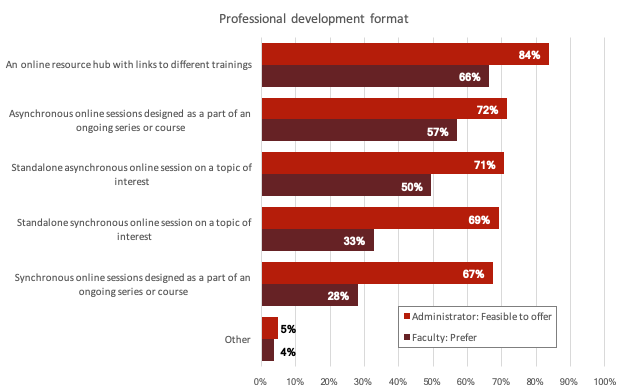Professional development for the 2020 fall semester: how to help faculty and administrators prepare
Based on a recent survey, both faculty and administrators agree that pedagogical strategies are needed for teaching online.

Online and hybrid learning is going to play a major role in the 2020-21 academic year at Canadian institutions of higher education. While the use of emergency remote teaching was necessary to address immediate needs, there is now a little bit more time to plan for the fall. What kinds of faculty professional development would be most helpful to faculty as they prepare for September? At the individual level these might include magnified workloads and at the institutional level, those might range from international student enrolment declines to organizing campus life to align with physical distancing guidelines.
As part of the Canadian Pulse Project, which is tracking the impact of the COVID-19 pandemic on higher education institutions, 273 faculty and administrators participated in a survey in April 2020 which asked them about professional development needs. The survey was a collaborative effort between Nicole Johnson (Canadian Digital Learning Research Association), George Veletsianos (Royal Roads University), Jeff Seaman (Bay View Analytics), and Academica Group.
Faculty were asked what they needed in preparation to teach effectively in an online format. Administrators were asked what they believed faculty at their institution needed.
Both faculty and administrators reported that their top three professional development needs (Figure 1) are the following:
1. Pedagogical strategies for teaching online,
2. Strategies for supporting students in learning online, and
3. Assessment strategies for teaching online.

To gain a sense of faculty professional development preferences, faculty were given a list of possible delivery formats and were asked which ones they preferred. Administrators were given the same list and were asked which formats would be feasible for their institution to offer.
All options provided to faculty and administrators are listed in Figure 2 below. The top response, from faculty and administrators alike, was an online resource hub with links to different trainings. Following that, faculty and administrators indicated that asynchronous online sessions designed as part of an ongoing series or course were preferred. Faculty indicated that they least preferred synchronous options. The greatest divergence between faculty and administrator selections were in the synchronous offerings.

Many unknowns surround the postsecondary education environment, but the need for professional development is urgent. Importantly, the sheer number of faculty using freely-available educational resources and participating in professional development opportunities made widely available by organizations such as BCCampus, eCampusOntario, Contact North, University of Windsor, and Royal Roads University, just to name a few, indicates that there is wide interest and much that we can all do to support one another in our efforts.
Faculty and administrators expressed a desire for an online resource hub. The good news is that online content is abundant, often provided with open licenses that allow individuals to reuse and remix it. However, we would urge organizations to resist the desire to develop new content. There is little need at this time to reinvent the wheel when numerous open educational resources on the topic are available that meet faculty needs. But providing content is rarely a solution. Rather, such content may need to be supplemented with support sessions answering faculty questions, fostering relationships between faculty teaching similar topics, and supporting one another. Thus, individuals and organizations also need to avoid the pitfall that a content hub will address all their professional development needs. Significantly, the findings around asynchronous access are also important to consider, because they highlight the need for flexibility.
We hope that these results provide institutions with some guidance as they work to develop professional development opportunities to support faculty for the fall 2020 semester.
Background to the research
Respondents included 273 higher education faculty and administrators from across Canada with most of the responses coming from Ontario, Alberta, and British Columbia. All data were checked for completeness, missing values, or erroneous codes. Where appropriate, questions included an “other” response where the respondent could provide their own detailed answer. All responses entered as “other” were reviewed to determine if they should also be coded as one of the fixed responses.
Of the total of 14 questions, 10 were displayed to faculty respondents and 13 to administrators. Since many academics have both teaching and administrative responsibilities, respondents were asked to select their primary role and were only presented with questions for that role. The only required question for the survey was that of the role of the respondent (faculty or administrator), so respondents could skip any question or portion of a question. Very few respondents skipped questions, but all surveys where less than three-quarters of the eligible questions were completed were deleted from the analysis.
Nicole Johnson is the research director at the Canadian Digital Learning Research Association. George Veletsianos is a professor in the school of education and technology at Royal Roads University. He also holds the Canada Research Chair in Innovative Learning and Technology.
Featured Jobs
- Indigenous Studies - Faculty PositionUniversité Laval
- Electrical and Computer Engineering - Assistant/Associate ProfessorWestern University
- Electrical Engineering - Assistant Professor (Electromagnetic/Photonic Devices and Systems)Toronto Metropolitan University
- Psychology - Assistant Professor (Social)Mount Saint Vincent University
- Accounting - Tenured or Tenure-Track Faculty PositionUniversity of Alberta















Post a comment
University Affairs moderates all comments according to the following guidelines. If approved, comments generally appear within one business day. We may republish particularly insightful remarks in our print edition or elsewhere.